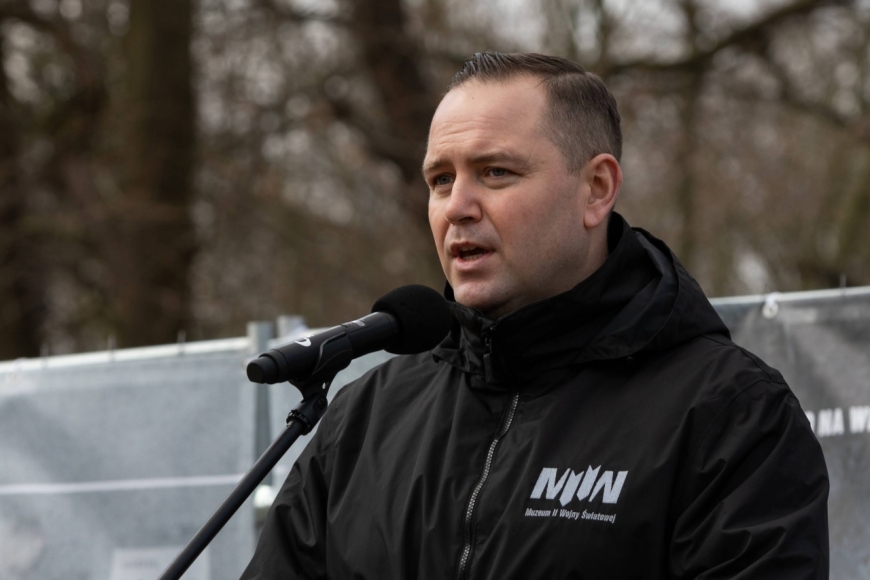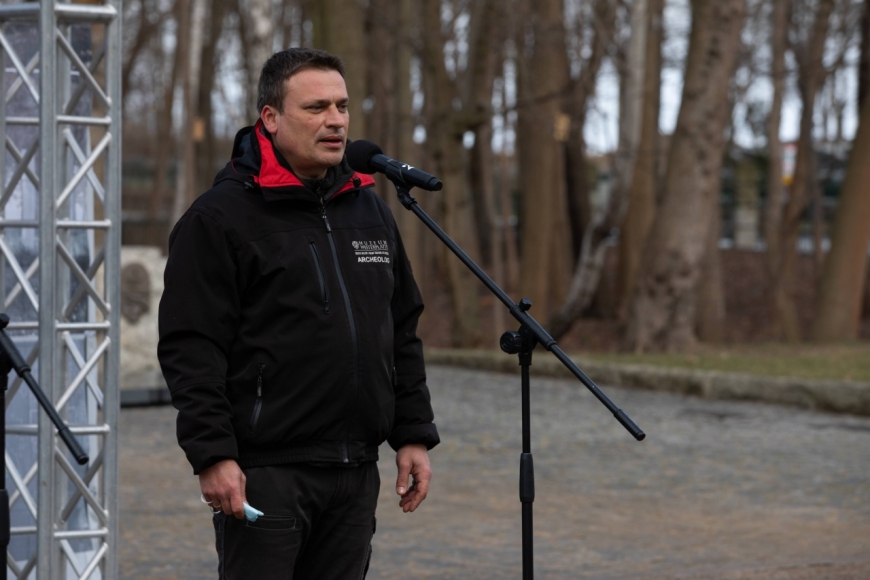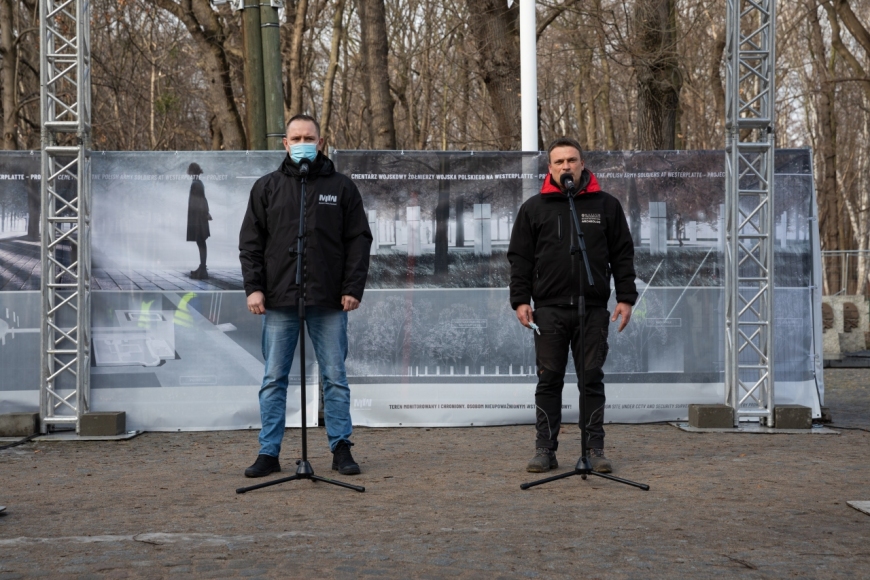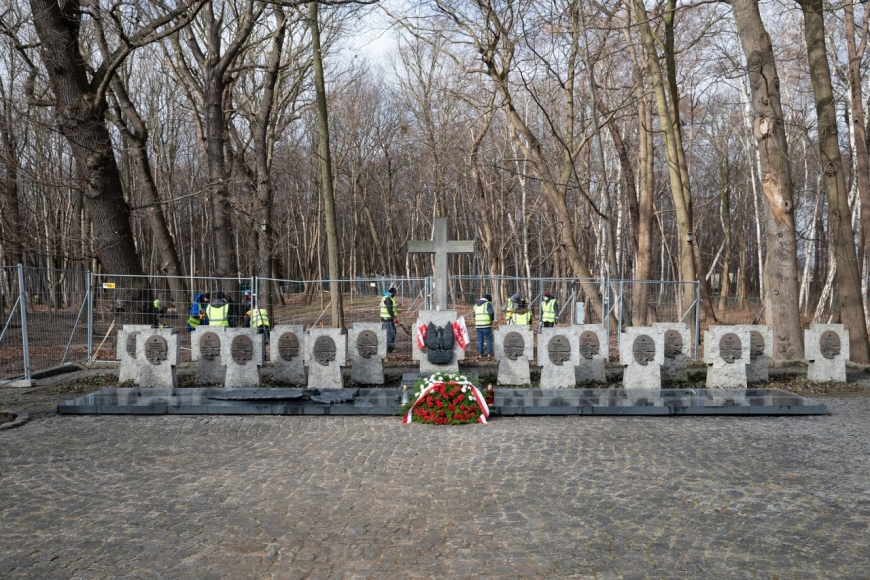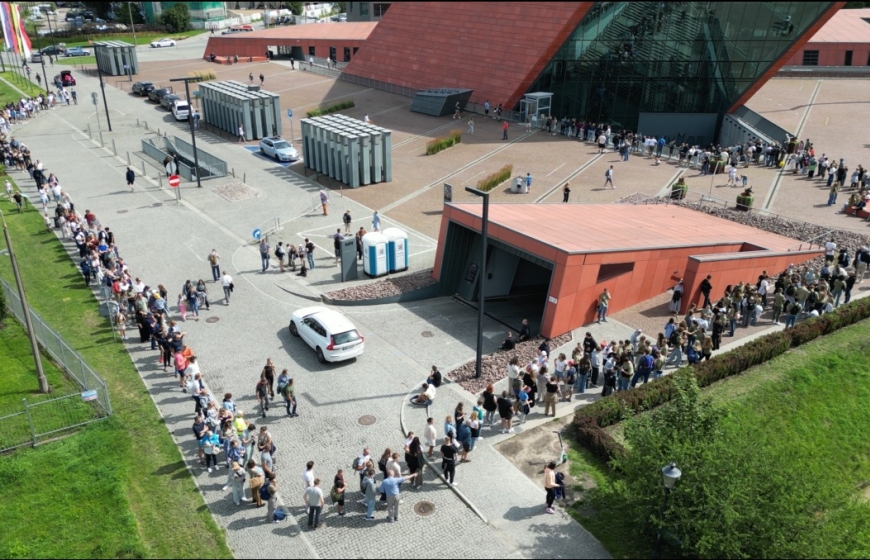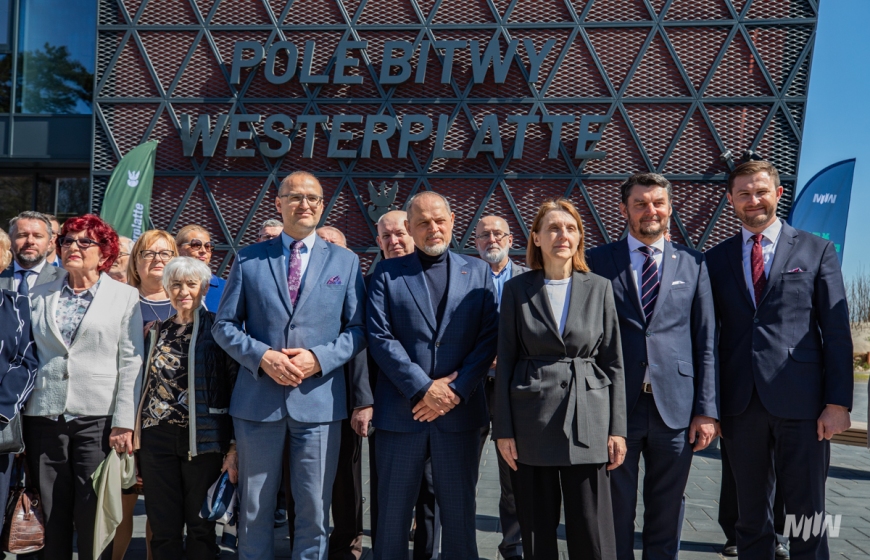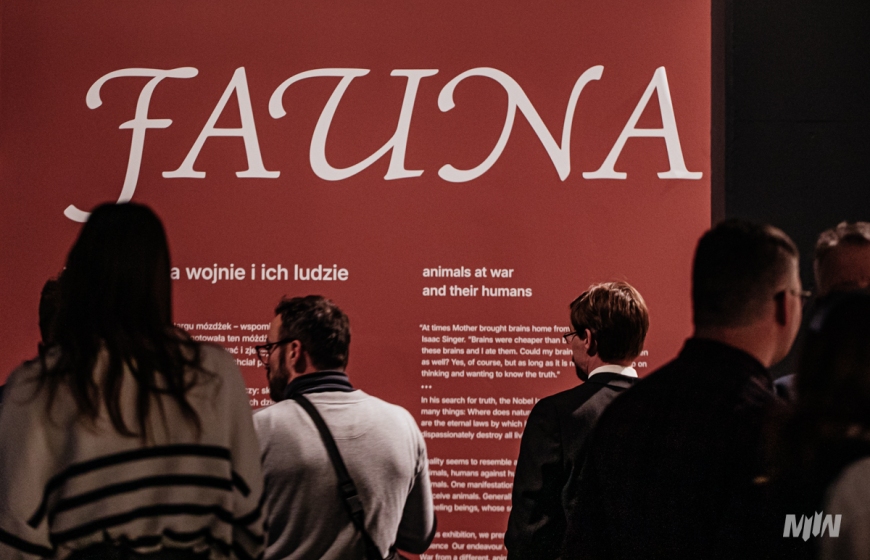2021 PLANS FOR THE CONSTRUCTION OF WESTERPLATTE AND THE WAR OF 1939 MUSEUM
A press conference organized by the Museum of the Second World War in Gdansk was held on March 12 at Westerplatte to present this year's plans regarding the construction of Westerplatte and the War of 1939 Museum. Dr. Karol Nawrocki, the director of the Museum of the Second World War in Gdansk, and Filip Kuczma, the Head of the Archaeology Department of the Museum attended the conference. The audience was informed about the upcoming development at Westerplatte and the start of archaeological and sapper's works, and geophysical research. Although another lockdown will be in place from 13th March, 2021, and museum exhibitions will be closed to visitors, the Museum of the Second World War in Gdansk is active in implementing the development project for Westerplatte and the War of 1939 Museum.
The director of the Museum of the Second World War in Gdansk, Dr. Karol Nawrocki said:
We would like to share with you good news that the whole development project at Westerplatte and the War of 1939 Museum is going as planned. Soon we will be able to see new outcomes of these operations. We are also completing our further commitments. In 2017, we promised not to leave, but also not to let ourselves be pushed out of the Westerplatte peninsula until we are absolutely certain that each of our heroes and defenders of Poland from September 1939 has been found. As of today, we have no such certainty, so we come back for our men, we come back for the Polish heroes. We begin stage 7 of archaeological works.
The head of Museum’s Department of Archeology, Filip Kuczma said:
During this stage we will focus on discovering and documenting the relics of two buildings important for the functioning and history of the Military Transit Depot at Westerplatte. One is Guardhouse no. 5. At least six Polish soldiers were killed there when it was destroyed on September 2, 1939. We will also research the Officers' Villa. These studies will help us to work out an idea of appropriate and permanent preservation of the remains of these buildings. The relics will be exhibited at the entrance area to the new Military Cemetery of the Polish Soldiers at Westerplatte. We will also continue our excavation work near the place where the graves of nine Polish soldiers were found.
POLISH ARMY SOLDIERS’ MILITARY CEMETERY AT WESTERPLATTE
In February this year, an agreement was signed between Museum of the Second World War in Gdansk and NM Architekci studio from Warsaw. The winning team will draft an architectural and urban plan for the Military Cemetery of Polish Army Soldiers at Westerplatte. The project will include the refurbishing of the cemetery together with unearthing the relics of the Guardhouse no. 5 and the Officer's Villa. The upcoming months will see the design activities in progress along with formal paper work. Pre-development work will also include archaeological research. The existing sections of the current cemetery will be dismantled and deposited in the museum’s warehouses and also partially at the archaeological base at Westerplatte. Special care will be given to the historical cross, which will be cleaned and restored. Then, for the duration of the construction work, it will be put on display nearby a pedestrian route leading up to the Westerplatte monument. In addition, the Museum will commission a specialist company to carry out exhumation works. The remains of Major Henryk Sucharski and Corporal Andrzej Kowalczyk laid to rest at Westerplatte will be temporarily deposited in St. Brigid's Basilica in Gdańsk, where they will remain until their ceremonial burial at the new cemetery. The burial will include other Defenders of September 1939 whose remains were found in the fall of 2019. Construction of the cemetery is scheduled to begin in December 2021. This project is one of the primary development activities within stage 1 of the investment – the construction of an open-air Westerplatte and the War of 1939 Museum, a branch of the Museum of the Second World War in Gdansk.
HISTORICAL POWER PLANT BUILDING
As part of stage 1 of the construction of Westerplatte and the War of 1939 Museum, carried out by the Museum of the Second World War in Gdansk, activities are being carried out with the aim of opening the historical Power Plant building to visitors in the fourth quarter of 2022. According to the development programme assumptions presented by the Museum on August 25, 2020, the building will house a modern exhibition presenting, among other things, the most important archaeological relics discovered during the consecutive seasons of excavations at Westerplatte. By the end of March this year, as part of a tender procedure announced on the Museum’s website, a design studio will be selected that will develop a project for the modernization of the Power Plant building along with the arrangement of its interior and the development of the entire property. The scope of work commissioned by the Museum will include comprehensive preparation of formal documentation, including necessary expert opinions and architectural-historical research, as well as full construction paperwork. The start of construction work on the historic Power Plant building and development of plot no. 3/5, area 062 Gdansk is scheduled for December 2021.
In addition, design work is being finalised for the completion of the fencing of the land property on which the historic Power Plant building is located. A tender procedure for construction works will be announced in April this year . The construction of the fence will make it possible to attach the Power Plant property to plot no. 68, area 062 (transferred to the Museum of the Second World War in Gdansk in 2020; based on the decision of the Pomeranian Governor), making the area available to visitors. The construction works are planned to be completed at the turn of the 2nd and 3rd quarter of 2021.
STAGE 2 AND 3 OF DEVELOPMENT PLAN - ARCHITECTURAL COMPETITION
In the fourth quarter of 2021, the Museum of the Second World War in Gdansk will announce an architectural contest for stage 2 and 3 of the construction of Westerplatte and the War of 1939 Museum. The development plan for this part of will see work done on the entire remaining area of the battlefield at Westerplatte that is accessible to visitors (except for the Cemetery and the Power Plant along with the development of the adjacent area, which are being constructed as part of stage 1). Thus, the architects will have to design the so-called Red Wall, the storage area (ammunition depots), the Stationmaster's Building, and the "Fort" Outpost. In addition the architects will have to design a brand-new facility housing the museum’s exhibition. The concept will also be extended to include conservation activities, i.e. renovation of the buildings and making the relics of historical buildings more legible, as well as the arrangement of the entire open-air area, including the recreation of the historical pathway layout of Westerplatte.
Preparatory and pre-project works are being carried out in order to prepare all formal documentation for the contest. Among other things, geotechnical surveys will help to outline the foundations of the buildings, determine the state of existing buildings, as well as conduct specialist and investment-related analyses. Furthermore, the Museum is in constant contact with the Pomeranian Voivodship Conservator of Monuments, responsible for coordinating construction work and issuing conservation guidelines for the historic battlefield at Westerplatte.
The winning architectural studio will be invited to negotiate the full design documentation for the above-mentioned stage 1 and 3 of the construction of Westerplatte and the War of 1939 Museum.
ARCHEOLOGY
On 12 March 2021 Museum of the Second World War in Gdansk begun the seventh stage of archaeological research at Westerplatte. This year's research is closely connected with development plans for a new Westerplatte and the War of 1939 Museum. The museum’s construction will be a part of a wider plan aiming at the revalorisation of the entire “Monument of History - Westerplatte Battlefield". The main goal of the 2021 archaeological research is to draft a comprehensive report on the relics of two buildings that were part of the Military Transit Depot: Guardhouse No. 5 and Officer's Villa. The assessment of the state of their preservation is necessary for the elaboration of a detailed project for their permanent protection and display. This assessment is a part of a wider project of the reconstruction of the Military Cemetery of Polish Soldiers at Westerplatte. The winning concept, in which the relics of the two buildings will form an important element of the cemetery's foreground zone, was selected in December 2020 as a result of an international urban planning and architectural contest hosted by the Museum of the Second world War in Gdansk. Moreover, this year's archaeological research will either confirm or rule out the existence of further burial pits in the area adjacent to the site where in autumn 2019 the graves of nine Polish defenders of Westerplatte were found. So far, an area of 500 m2 has been surveyed at this site, while this year a further 200 m2 will be covered.
SAPPER WORK
One of the key tasks in the revitalisation and revalorisation of the former Military Transit Depot Westerplatte carried out by the Museum of the Second World War in Gdansk is to ensure the safety of visitors to the peninsula. A monument to history and a former site of various battles, and later testing ground for explosive demolitions, the Battlefield of Westerplatte not only hides artefacts of historical importance, but also has many dangerous and explosive materials of military origin still buried in the ground. From 15 March 2021 to the second half of April this year, Polish Army sappers will begin the next stage of clearing work to remove explosives and hazardous materials. The de-mining operation will be spread over the area of 66 300 m² (6.63 ha). Work carried out by the sappers of the Polish Army (Sappers Company of the Engineering Battalion of the 2nd Sappers Regiment from Kazun Nowy), under the supervision of archaeologists from the Second World at Museum in Gdanks, will not only guarantee the visitors’ safety, but will also yield many valuable relics related to the service of Polish soldiers at Westerplatte and the heroic defence of the Military Transit Depot in September 1939.
GEOPHYSICAL SURVEYS
In the second half of March this year, The Museum of the Second World War in Gdansk will commence a comprehensive geophysical survey of the area of the former Military Transit Depot at Westerplatte. In the first stage, the survey will cover the area of plot no. 68, area 062 in Gdansk. This will be the first large-scale geophysical survey of the Westerplatte area using a variety of methods. These non-invasive research methods will make it possible to obtain detailed information on the location and size of relics of original Westerplatte buildings that today are covered with a layer of soil. Numerous bomb and artillery shell craters that, as well as other archaeological objects located on the peninsula will be researched, too. This information, when compared with LIDAR data and archival aerial photographs, will allow to create a multilayer map of Westerplatte, accurately identifying places where material remnants of past human activity may still be hidden underground. Moreover, the geophysical survey will help to locate and choose the sites for future archeological survey and create a database of those sites.













